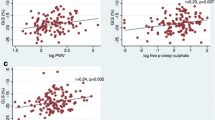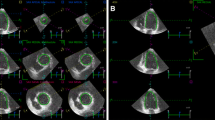Abstract
It has been shown that there is an increased risk of cardiovascular events such as heart failure and death in nephrotic syndrome. Left ventricle global longitudinal strain (LVGLS) is a more sensitive measure of assessing myocardial dysfunction and is more reproducible than left ventricle ejection fraction (LVEF%). LVGLS can detectsubclinical deterioration in the left ventricle early. In this study, we aimed to investigate LVGLS in Primary Nephrotic Syndrome (PNS) patients with normal LVEF%. Patients with histopathologically confirmed PNS were evaluated for this prospective single-center study. Patients with similar age and gender characteristics without nephrotic syndrome were included as the control group. LVGLS measurements were performed by 2D speckle tracking echocardiography. A total of 171 patients, 57 with PNS and 114 in the control group, were included in the study. The mean age was 38±12 years in the study population, and 95(56%) of the patients were women. LVEF% was 60.2±4.2 in the PNS group and 61.1±3.2 in the control group, and there was no significant difference between the two groups (p=0.111). LVGLS was found to be significantly lower in the PNS group (-19.3±2.3% vs.-20.8±1.5 %, p<0.001). A significant relationship was observed between PNS and LVGLS in the multivariable linear regression analysis (β= 4.428, CI 95% =0.57?1.48, p<0.001). A significant relationship was observed between PNS and LVGLS, and LVGLS was found to be lower in PNS patients. In patients with PNS, subclinical left ventricular systolic dysfunction may be detected in the early period by measuring LVGLS.


Similar content being viewed by others
References
Gansevoort RT, Correa-Rotter R, Hemmelgarn BRet (2013) Chronic kidney disease and cardiovascular risk: epidemiology, mechanisms, and prevention. Lancet 382:339–352
Kodner C (2016) Diagnosis and management of nephrotic syndrome in adults. Am Fam Physician 93:479–485
Hull RP, Goldsmith DJ (2008) Nephrotic syndrome in adults. BMJ 336:1185–1189
Go AS, Tan TC, Chertow GM et al (2021 Sep) Primary nephrotic syndrome and risks of ESKD, Cardiovascular events, and death: the Kaiser Permanente Nephrotic Syndrome Study. J Am Soc Nephrol 32(9):2303–2314
Ikonomidis I, Andreou I, Parissis J et al (2018 Mar) Prognostic significance of global longitudinal strain in chronic kidney disease: the evidence is building. Eur J Heart Fail 20(3):569–571
Liu YW, Su CT, Sung JM et al (2013) Association of left ventricular longitudinal strain with mortality among stable hemodialysis patients with preserved left ventricular ejection fraction. Clin J Am Soc Nephrol 8:1564–1574
Kramann R, Erpenbeck J, Schneider RK et al (2014) Speckle tracking echocardiography detects uremic cardiomyopathy early and predicts cardiovascular mortality in ESRD. J Am Soc Nephrol 25:2351–2365
Krishnasamy R, Isbel NM, Hawley CM et al (2015) Left ventricular global longitudinal strain (GLS) is a superior predictor of all-cause and cardiovascular mortality when compared to ejection fraction in advanced chronic kidney disease. PLoS ONE 10:e0127044
Krishnasamy R, Isbel NM, Hawley CM et al (2014) The association between left ventricular global longitudinal strain, renal impairment and all-cause mortality. Nephrol Dial Transplant 29:1218–1225
Pressman GS, Seetha Rammohan HR, Romero-Corral A et al (2015) Echocardiographic strain and mortality in Black Americans with end-stage renal disease on hemodialysis. Am J Cardiol 116:1601–1604
Panoulas VF, Sulemane S, Konstantinou K et al (2015) Early detection of subclinical left ventricular myocardial dysfunction in patients with chronic kidney disease. Eur Heart J Cardiovasc Imaging 16:539–548
AbdelMassih A, Haroun M, Samir M et al (2021) Hypoalbuminemia linked to myocardial dysfunction in recent-onset nephrotic syndrome: a cross-sectional case control 3DSTE study. Egypt Pediatr Association Gaz 69:24
Bryan Williams G, Mancia W, Spiering, ESC Scientific Document Group, 2018 ESC/ESH guidelines for the management of arterial hypertension: the Task Force for the management of arterial hypertension of the European Society of Cardiology (ESC) and the European Society of Hypertension (ESH),European Heart Journal, Volume 39, Issue 33, 01 September 2018, Pages3021–3104, https://doi.org/10.1093/eurheartj/ehy339
McDonagh TA, Metra M, Adamo M et al (2021) 2021 ESC Guidelines for the diagnosis and treatment of acute and chronic heart failure. Eur Heart J 42:3599–3726. https://doi.org/10.1093/eurheartj/ehab368
Voigt JU, Pedrizzetti G, Lysyansky P et al (2015) Definitions for a common standard for 2D speckle tracking echocardiography: Consensus document of the EACVI/ASE/ industry Task Force to standardize deformation imaging. J Am Soc Echocardiogr 28:183–193
Go AS, Chertow GM, Fan D et al (2004) Chronic kidney disease and the risks of death, cardiovascular events, and hospitalization. N Engl J Med 351:1296–1305
Matsushita K, Coresh J, Sang Y, Chalmers J, Fox C, Guallar E et al (2015) Estimated glomerular filtration rate and albuminuria for prediction of cardiovascular outcomes: a collaborative meta-analysis of individual participant data. Lancet Diabetes Endocrinol 3:514–525
Chen SC, Huang JC, Su HM et al (2018) Prognostic cardiovascular markers in chronic kidney disease. Kidney Blood Press Res 43:1388–1407
Tops LF, Delgado V, Marsan NA et al (2017) Myocardial strain to detect subtle left ventricular systolic dysfunction. Eur J Heart Fail 19:307–313
Russo C, ** Z, Elkind MS et al (2014) Prevalence and prognostic value of subclinical left ventricular systolic dysfunction by global longitudinal strain in a community-based cohort. Eur J Heart Fail 16:1301–1309
Paraskevaidis IA, Ikonomidis I, Simitsis P et al (2017) Multidimensional contractile reserve predicts adverse outcome in patients with severe systolic heart failure: a 4-year follow-up study. Eur J Heart Fail 19:846–861
Dogdus M, Simsek E, Cinar CS (2019 Feb) 3D-speckle tracking echocardiography for assessment of coronary artery disease severity in stable angina pectoris. Echocardiography 36(2):320–327. https://doi.org/10.1111/echo.14214
Dogdus M, Demir E, Cinar CS, Gurgun C Coronary tortuosity affects left ventricular myocardial functions: a 3D-speckle tracking echocardiography study.Int J Cardiovasc Imaging. 2020Apr; 36(4):627–632. doi: https://doi.org/10.1007/s10554-019-01760-0
Carracedo J, Alique M, Vida C et al (2020) Mechanisms of Cardiovascular Disorders in patients with chronic kidney disease: a process related to Accelerated Senescence. Front Cell Dev Biol 8:185
Chirakarnjanakorn S, Navaneethan SD, Francis GS et al (2017) Cardiovascular impact in patients undergoing maintenance hemodialysis: clinical management considerations. Int J Cardiol 232:12–23
Kaur P, Singh B, Patel P et al (2020 Mar) Non-ischemic cardiomyopathy with focal segmental glomerulosclerosis. J Community Hosp Intern Med Perspect 3(2):154–157
London GM, Pannier B, Guerin AP et al (2001) Alterations of left ventricular hypertrophy in and survival of patients receiving hemodialysis: follow-up of an interventional study. J Am Soc Nephrol 12:2759–2767
Qin Q, Xu R, Dong J et al (2010) Evaluation of right ventricle function in children with primary nephrotic syndrome. Pediatr Neonatol 51:166–171
Moreira-Rodrigues M, Roncon-Albuquerque R Jr, Henriques- Coelho T et al (2007) Cardiac remodeling and dysfunction in nephrotic syndrome. Kidney Int 71:1240–1248
Adedoyin O, Frank R, Vento S et al (2004) Cardiac disease in children with primary glomerular disorders-role of focal seg- mental glomerulosclerosis. Pediatr Nephrol 19:408–412
Suranyi MG, Guasch A, Hall BM et al (1993) Elevated levels of tumor necrosis factor-alpha in the nephrotic syndrome in humans. Am J Kidney Dis 21:251–259
Kim SY, Lim AY, Jeon SK et al (2011) ; 2011: 945123
Oflaz H, Sen F, Bayrakli SK et al (2008) Reduced coronary flow reserve and early diastolic filling abnormalities in patients with nephrotic syndrome. Ren Fail 30(9):914–920
Ikonomidis I, Tzortzis S, Triantafyllidi H et al (2015) Association of impaired left ventricular twisting–untwisting with vascular dysfunction, neurohumoral activation and impaired exercise capacity in hypertensive heart disease. Eur J Heart Fail 17:1240–1251
Funding
No funding.
Author information
Authors and Affiliations
Contributions
NKÇ, EA, MÇ: prepared the first draft. MÇ and MÖ analyzed echocardiographic images. All authors participated in the concept development and research design and revision of the article. All authors have read and approved the final article.
Corresponding author
Ethics declarations
Competing interests
The authors declare no competing interests.
Conflict of Interest
The authors have no conflict of interest to declare.
Additional information
Publisher’s Note
Springer Nature remains neutral with regard to jurisdictional claims in published maps and institutional affiliations.
Rights and permissions
Springer Nature or its licensor (e.g. a society or other partner) holds exclusive rights to this article under a publishing agreement with the author(s) or other rightsholder(s); author self-archiving of the accepted manuscript version of this article is solely governed by the terms of such publishing agreement and applicable law.
About this article
Cite this article
Çap, N.K., Aydın, E., Kadiroğlu, A.K. et al. Left ventricular global longitudinal strain can detect subclinical left ventricular systolic dysfunction in adult patients with primary nephrotic syndrome. Int J Cardiovasc Imaging 39, 1097–1104 (2023). https://doi.org/10.1007/s10554-023-02817-x
Received:
Accepted:
Published:
Issue Date:
DOI: https://doi.org/10.1007/s10554-023-02817-x




